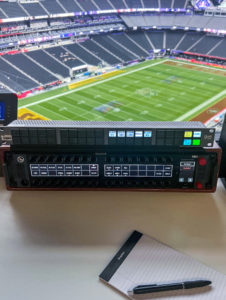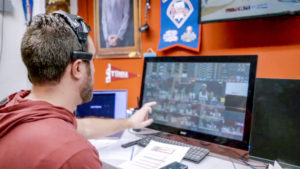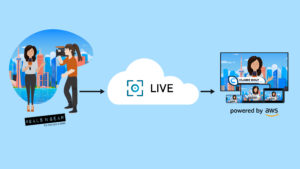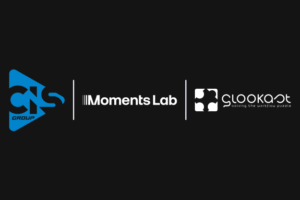Rob Green,
Senior Manager - Pro AV, Broadcast & Consumer, AMD Xilinx
Introduction
AV-over-IP, or the transport of audio, video and data over an IP network, has enabled a seismic shift in how broadcast equipment is built, deployed and used. We’re in a transition from capex to opex models in broadcast. Moving from specialised units for media processing, to high performance hardware platforms which can be repurposed on-the-fly to support single or multi-channel AV processing and routing, and on to virtualized media applications which can be provisioned and paid for only when you need them. But the AV-over-IP story needn’t stop there. It can also offer a way to expand your business into the world of pro AV. A separate entity to broadcast, pro AV covers a much larger available market (figures 1 & 2), including live events such as music performances, theatre, conferences etc., government, control rooms, education, high-end residential, retail signage and displays, and more. These trends are driving demand for adaptive computing solutions that provide the necessary flexibility to deploy and redeploy pro AV technology for a wide range of use-cases.

Figure 1 - Broadcast market (source: AMD Xilinx estimate)

Figure 2 - Pro AV market (source: AMD Xilinx estimate)
Other differences include the use of connectivity standards such as HDMI™, DisplayPort™ and HDBaseT™ rather than SDI. It’s a more cost-sensitive market and is also fragmented today with many manufacturers offering limited interoperability because they historically owned both ends of the AV link. The need for technical robustness and tight synchronization is there, but currently much less rigorous than broadcast. Generally, pro AV installers and users are adopting similar types of equipment to what you’re probably already building for broadcast.
The opportunity to expand
The pro AV market is undergoing a transformation and experiencing a shift to IP networking. Just like broadcast suffered through the times before SMPTE ST 2110 was chosen as the industry standard, the pro AV market has entered a frantic period of competitive positioning with various flavours of AV-over-IP standards and protocols such as IPMX, NDI®, SDVoE™ and Dante™. Each have pros and cons, and all claim to be the best. However, the widespread use of reprogrammable hardware such as FPGAs (field programmable gate array) and adaptive SoCs (system on a chip) and new software-only implementations means that equipment can adapt to different standards as needed, and bridge between them depending on use case.
As a broadcast supplier, it’s possible to take advantage of some of the cross-over technologies to expand the footprint into the larger pro AV space. For instance, IPMX (IP Media Experience) is an emerging networking standard from the AIMS Alliance, which is built on SMPTE ST 2110. It uses the same techniques as ST 2110 to packetize audio, video and data, JPEG XS as the main compression codec (for now), and NMOS (Network Media Open Specifications) for a standardized control plane. For pro AV, it adds extra functionality for handling HDMI features and offers PTP (precision timing protocol) and non-PTP methods for synchronization. Most organisations in the broadcast space probably already have, or are developing an ST 2110 system, so it’s not a huge stretch to adapt that platform to also support IPMX and be integrated into many pro AV systems requiring similar audio/video processing functionality. IPMX is of particular interest in pro AV right now because it is the only truly open standard – as well as being scalable and interoperable, it is entirely vendor-independent. This means that you can build your own implementation of IPMX without waiting for a particular manufacturer’s device to support it or being beholden to any changes made by a single company without having any control over it. It also means that IPMX can scale to support any resolution of AV and isn’t fixed to a single Ethernet bandwidth such as 1GbE or 10GbE.
Building bridges
IPMX is not the only way to use IP protocols to bridge the worlds of broadcast production and pro AV presentation and collaboration. NDI (Network Device Interface) is hugely popular in studio and remote production facilities because of its ease-of-use. In fact, NDI is already often used to ingest from broadcast PTZ cameras on location or within studios and easily stream them as a source over conferencing software such as Microsoft Teams® or Zoom. It’s used for live streaming from corporate events and for vloggers to stream e-sports commentary. NDI offers broadcast quality AV on any IP network (IPMX will tend to need its own network due to the higher bitrate needs currently), as it is highly compressed compared to IPMX, so it’s likely that both will coexist in various environments. Audinate’s Dante is another protocol widely used in the professional audio domain for both broadcast and pro AV, and is an example of how IP-based protocols can easily span both markets if they’re easy-to-use, offer low latency and high-quality AV.
Whilst there are many competing standards and protocols vying for the same space in pro AV, the hardware involved remains constant and is found in most ST 2110 broadcast systems anyway. FPGAs and hardware reprogrammable SoCs offer the ability to switch functionality on-the-fly, support various baseband AV interfaces such as HDMI, DisplayPort and SDI, and Ethernet MACs for the all-important AV-over-IP interface. Most of the IP protocols discussed can target these devices (Figure 3 shows NDI and IPMX), so they can be programmed as needed, and potentially even form bridges between them. In most cases the real difference between the AV-over-IP protocols is the codec involved, so transcoders can be made to handle any incoming stream as needed.

Figure 3 - NDI demo (top), IPMX demo from Nextera Video and Adeas (bottom),

Making the shift
Of course, the transition into pro AV isn’t simply a case of rebadging your product, but much of the technical development work has already been done – providing the opportunity to adopt one or many of the AV-over-IP protocols being considered in that market. A growing number of organisations in broadcast have successfully pivoted some of their product lines to move into the larger pro AV space, and the lines between the markets continue to blur, driven largely by the Covid-19 pandemic and subsequent shift to remote production, live streaming and collaboration. Solutions such as FPGAs and reprogrammable SoCs broadcast manufacturers use today have the capability to adapt should you want to expand your business into pro AV in a relatively low-risk way.









